Lavender provides a Mediterranean flair in every garden. You can find out everything about lavender – from planting to cutting – in this article.
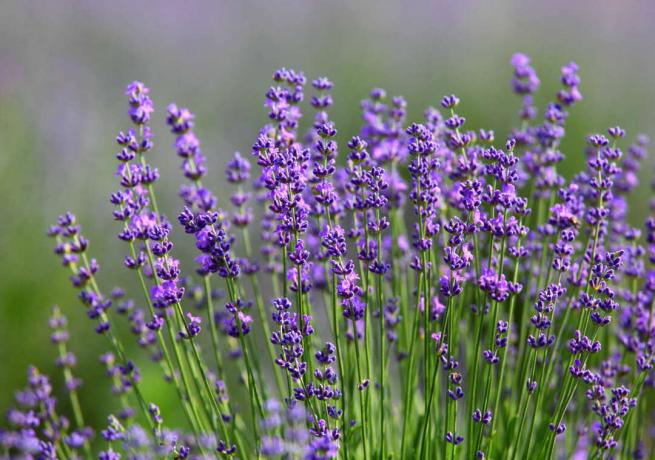
The true lavender (Lavandula angustifolia) has always been popular not only in the Mediterranean region and has long been one of the best-known herbs and medicinal plants. The subshrub of the mint family (Lamiaceae) originally comes from the Mediterranean region, but with the right care is easy to cultivate in our latitudes.
Like many other herbs from the Mediterranean region, lavender is one of the subshrubs that grow in the In contrast to herbaceous plants such as perennials, do not soak completely into the ground in winter, but from below lignify. This means they can cope well with higher temperatures and periods of drought.
contents
- Origin and history of lavender
- Buying lavender: You should pay attention to this
- Lavender Varieties: Popular and Well-Known Varieties and Species
-
Planting lavender: location, bed neighbors and procedure
- Plant lavender in a pot
- Plant a lavender tree
- Lavender flowering time: when does lavender bloom?
-
care for lavender
- Water the lavender in the bed and in the pot
- Cut lavender
- Fertilize and lime lavender
- Overwinter lavender
- Grow lavender
- Harvesting, drying and storing lavender
-
Lavender: ingredients and use as a medicinal plant
- Lavender: Use as a medicinal plant
- Lavender: Use in kitchen and household
- Lavender against mosquitoes and moths
- Lavender: diseases and pests
Origin and history of lavender
In its homeland, the warm countries of the Mediterranean, the real lavender prefers dry slopes and stony soils and has penetrated up to mountainous regions of 1600 meters in height. Lavender has been used in cosmetics and medicine since ancient times. Lavender owes its name to this circumstance, which is derived from the Latin word “lavare” (meaning “to wash”). Pliny already reported on lavender oil as a fragrant additive in bath water. The lavender plant finally reached us across the Alps in the luggage of Benedictine monks, who cultivated it as a medicinal herb in the monastery garden. Lavender was used to treat a wide variety of ailments and was even said to help against the plague. Incidentally, lavender was not first cultivated commercially in Provence in France, but in England. Already Queen Elizabeth I. used it as a perfume and Queen Victoria was also an enthusiastic lover of the fresh, herbaceous lavender scent. In areas like Kent and Norfolk you can still admire English lavender fields today. In addition, there are always numerous new breeds from England.
Buying lavender: You should pay attention to this
Both lavender seeds and pre-grown young plants are commercially available. In the garden center you will usually only find a few Varieties of True Lavender (Lavandula angustifolia) and des French lavender (Lavandula stoechas). There are rarer specimens in perennial nurseries, in tree nurseries or in online shops. However, when choosing the variety, consider the later intended use, because not every lavender is suitable for the garden bed. While the real lavender is relatively hardy, the frost-sensitive French lavender is only suitable for pot cultivation in our latitudes. What you at Buying lavender We explain anything else you should consider in our special article.

Lavender Varieties: Popular and Well-Known Varieties and Species
Of the 25 types of lavender known today, the real lavender is the most popular and comes up with indiscriminate varieties. Even with the foliage, there are nuances between the individual varieties, ranging from dark green to almost silvery white tones. The flower colors are even more diverse, showing a wide spectrum of blue and purple tones, but also pink and white. Common lavender usually reaches an impressive height of 60 to 70 cm. However, new breeds can be significantly lower, so that the right variety can be found for every garden. The dwarf forms of lavender with a height of 25 to 35 cm, on the other hand, do not grow as quickly and tend to be narrower and more compact than their relatives. That is why they are particularly suitable as tub plants and as border for beds. Below we have listed some of the most popular and well-known lavender varieties. Further Varieties of True Lavender can also be found here.
'Blue Cushion': Compact cultivar with squat spikes and large, long-lasting, light purple flowers; well suited for pot culture or the rock garden; dwarf form
'Dwarf Blue': Proven, medium-tall variety with grey-green foliage and violet flowers, which is well suited as a bed border and scented hedge
'Hidcote Blue': Proven variety from England with dark blue-violet flowers and a strong fragrance; compact and slow-growing, however, under ideal growing conditions the plants can become quite large; Growth height: 30 - 60 cm

'munstead': A particularly early flowering cultivar from England with midnight blue flowers and attractive silver-grey foliage; intense fragrance; compact growth, therefore very well suited for bed edging
'Nana Alba': Slow growing dwarf form with a bushy structure and white flowers
However, the variety of lavender is much larger. In our special article you will find an overview of the best Varieties and species of lavender for beds and pots.
And also the kind of French lavender we took a closer look here. A special variety is the des white lavender, which we will examine in more detail here.
Planting lavender: location, bed neighbors and procedure
Lavender plants love warm, full sun locations with well-drained, calcareous soil. Since they do not appreciate waterlogging at all, a drainage layer of pebbles should be laid when planting and sand mixed into the substrate. The real lavender in the bed gets along very well with other Mediterranean herbs that have similar location requirements, for example sage (Salvia), thyme (thymus) or mountain savory (Satureja montana). In addition, lavender is an excellent pasture for insects, so that when it blooms, the flower spikes are teeming with butterflies, bees and bumblebees.
One often reads about lavender as the ideal companion for roses, which is said to protect them from aphid infestation, for example. Due to the different location requirements of the two plants, roses (pink) and lavender but not such a dream couple as assumed. More recommended here are, for example, catnip (Nepeta cataria) or the Steinquedel (Calamintha nepeta subsp. nope). If you still don't want to do without lavender in the rose bed, you should keep a minimum distance of 80 Keep a distance of up to 100 cm between the plants and the planting hole for the lavender with some sand lose weight Lavender is also ideal as a fragrant bed border or low hedge. For this purpose, about three plants should be planted per running meter.
This is the best way to go about planting lavender:
- Choose a warm, sunny location
- Dig a sufficiently large planting hole
- Mix heavy garden soil with sand
- Place the lavender plant in the middle
- Fill in with loose, calcareous soil
- Press lightly and pour well
In this article we will explain to you what is involved in the planting of lavender else to consider.
Plant lavender in a pot
The lavender also thrives well in pots and brings a Mediterranean flair to the terrace and balcony. However, you should make sure that the water can drain off well and that there is no waterlogging, especially when cultivating in pots. The pot should therefore definitely have a drainage hole. A drainage layer of expanded clay or pebbles and a rather nutrient-poor and calcareous substrate also ensure that the plant thrives. the Plantura Organic Herb & Seed Soil is ideal for Mediterranean herbs such as lavender. More information about Planting lavender in a pot you'll find here.
Smaller varieties are particularly suitable for pot culture. Special Lavender varieties suitable for pots can be found in our special article.

Plant a lavender tree
The designation as a tree is actually nonsensical in connection with lavender, because botanically the Mediterranean herb is one of the subshrubs. As such, it becomes lignified with age and can even form a trunk with appropriate training. Whether lavender is hardy as a standard tree depends on the variety from which it was grown. It is therefore best to plant your lavender tree in a pot and bring it inside in winter.
A sheltered place in the garden or on the balcony is suitable as a location for the summer. When planting, however, be sure to choose a sufficiently large bucket, because the roots of lavender require a lot of space. The lavender tree feels most comfortable in loose, sandy substrate and will thrive wonderfully with optimal care. For more information on the correct Taking care of your lavender tree can also be found in our special article.
Lavender flowering time: when does lavender bloom?
There is no general answer to the question of when lavender blooms, because the flowering time depends primarily on the variety. The French lavender opens its flowers as early as May and is therefore one of the early bloomers of the Lavandula-Genus. It is characterized above all by its long flowering period until August or even September. True lavender, on the other hand, was originally only to be found in higher mountain regions and therefore only opens its flowers from the beginning of June. However, it is extremely robust and can even be overwintered outside. A short time later the spike lavender begins (Lavandula latifolia) to bloom.
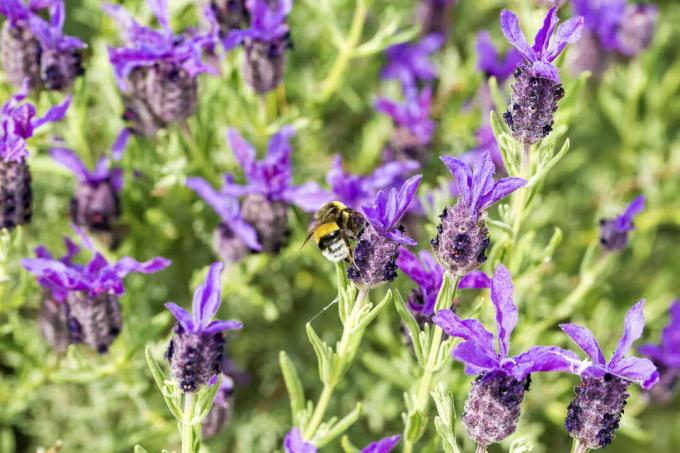
Of course, the flowering time not only depends on the species or variety, but also on the weather, soil conditions and care. Under optimal conditions, your lavender will bloom profusely in the warm summer months and spread its fragrance in the garden for several months.
How you die Flowering time of lavender can be extended, we explain here.
care for lavender
An adequate supply of nutrients and water is vital for your lavender. However, regular pruning and forest protection measures are also of great importance for splendid growth and many fragrant flowers. Below we go into the care of lavender in general.
More information about Cultivation of French lavender can also be found in this special article, more about the general one Care of lavender also here.
Water the lavender in the bed and in the pot
Over time, lavender has adapted to the site conditions of its Mediterranean homeland, so that it thrives very well on poor soil and with little water. With its long taproot, it is able to pull water and nutrients up from deeper layers of the earth. However, it is very sensitive to waterlogging and tends to root rot if there is too much moisture. In the bed, lavender only needs to be watered during long dry periods. Potted lavender, on the other hand, cannot develop long taproots and should therefore be watered more regularly. The top layer of soil should be allowed to dry between waterings and any water in the trivet should be drained off to prevent root rot.

Everything around watering lavender in beds or pots can also be found in more detail in our special article.
Cut lavender
Lavender is a semi-shrub, which means that the annual, green shoots become woody from below over the years. For the cut, this means that a few centimeters of the green wood from the previous year may remain and should only be carefully cut into the woody part. Old, bald lavender bushes that have not been cut for several years are allowed Under no circumstances should they be radically shortened, as the plants from very old wood are only reluctant or not at all cast out Regular pruning measures in late spring and summer are therefore important to prevent balding and to keep the plants compact.
However, you should not cut after the beginning of August or even in autumn. As soon as the lavender begins to sprout in spring, a vigorous pruning of up to two is necessary Thirds of the foliage possible to rejuvenate the plant and encourage a branched growth to stimulate When cutting, you should also make sure that the plant has an even round shape. A hedge trimmer is particularly suitable for this. A slight pruning of about a third of the leaf mass after flowering stimulates the plant to grow again and promotes bushy growth. For a time-saving summer pruning, the stems of the flower spikes can also be tied together and the whole bunch cut off at once.
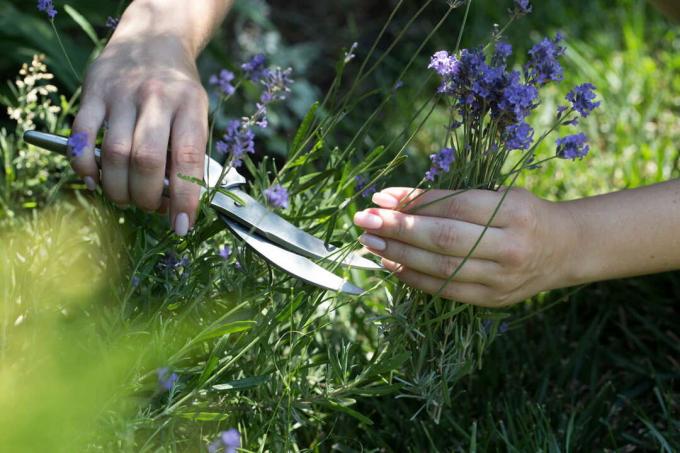
A more detailed guide to Cutting lavender in spring and summer can be found in our special article.
Fertilize and lime lavender
In its natural environment, lavender grows on poor, stony soil and can therefore also cope with few nutrients. It is best to work some fertilizer or compost into the soil when planting. In the following years, an annual basic fertilization at the beginning of the growth phase (March/April) is sufficient. Additional fertilization at the beginning of summer also optimally supplies your lavender in pot culture.
Mainly organic fertilizers with a long-term effect like ours Plantura organic universal fertilizer are particularly suitable for your lavender in the garden and in pots, as they decompose slowly and provide the plant with sufficient nutrients over the long term. You can also improve lime-poor soils in the spring with a handful of commercially available garden lime. But make sure beforehand that you really have real lavender in your garden. For close relatives - like the French lavender - calcareous soils are rather disadvantageous.

As Fertilize and lime lavender should, we will explain to you again in detail in our special article.
Overwinter lavender
The following applies to the winter months: Plants planted in pots are more sensitive to frost than those in beds, so a wind and rain-protected location and good winter protection are a must. For example, the pot can be wrapped in several layers of bubble wrap to prevent the root ball from freezing. The aerial parts of the lavender plant can also be covered with fleece. So that the root ball does not dry out completely, you should water sparingly - but only on frost-free days.
Detailed information about Overwintering lavender in beds and in pots are available here. Should you be looking for hardy lavender varieties be sure to find what you are looking for in our special article.
Grow lavender
Lavender can be propagated by seeds, cuttings and planters. For the hobby garden, the propagation of cuttings is certainly the most reliable and fastest option. This ensures that the varietal characteristics are passed on unchanged, because plants propagated by seeds often deviate greatly from the habit of the mother plant.
Ideal times for the propagation of cuttings are early spring and late summer. The fresh cuttings from cutting can be used very well here. About 10 cm long, unbranched shoot tips without flowers are particularly suitable for the propagation of cuttings. All leaves are carefully removed from the lower third of the cuttings, then the shoots are planted in a mixture of sand and potting soil and kept moist. Once the shoots have formed roots, they can be isolated. In this state, however, the little plants cannot withstand the winter, so that if they are propagated by cuttings in late summer, they overwinter frost-free and are not planted out until spring.
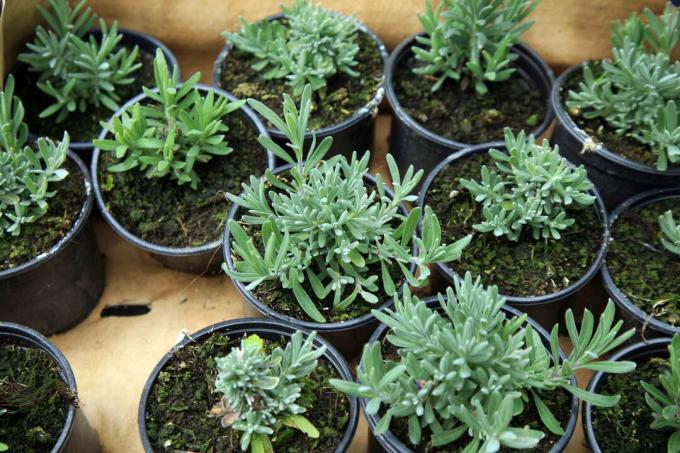
If you still want to try the seed, you should definitely note that lavender germinates in the light. The seeds should therefore not be covered with soil, but only lightly pressed onto the moist potting soil. After about two weeks in a bright, warm location, the first seedlings will appear. As soon as the first leaves have appeared, the seedlings can be pricked out. However, the young plants are only allowed outside when cold temperatures are no longer to be expected, i.e. at the end of May at the earliest.
More information about Propagation of Lavender through cuttings, sowing and division can be found in our special article.
Harvesting, drying and storing lavender
The flowers of the lavender in particular, but also the young leaf shoots, are used in the kitchen, household and cosmetics. It is therefore harvested during the flowering period between June and August, as soon as the flowers open. To avoid mold growth when drying the flowers, a dry harvest day should be chosen - this also shortens the drying time. Directly after harvesting, the flower spikes should be allowed to dry loosely spread out on a cloth. You can either hang them up in bundles or leave them on the cloth to dry thoroughly. The dried lavender flowers should then be stored in a dark, dry and cool place.
A detailed guide to Drying Lavender you'll find here.
Lavender: ingredients and use as a medicinal plant
Real lavender is used in the kitchen as well as in cosmetics and medicine. It contains many tannins and other secondary plant substances and up to 3% essential oil, which gives it its characteristic aroma. The composition of lavender oil is extremely complex and currently includes over 150 different compounds. Linalool and linalyl acetate together account for up to 75%. But other components – such as cineol, borneol and camphor – are also crucial for the characteristic scent.
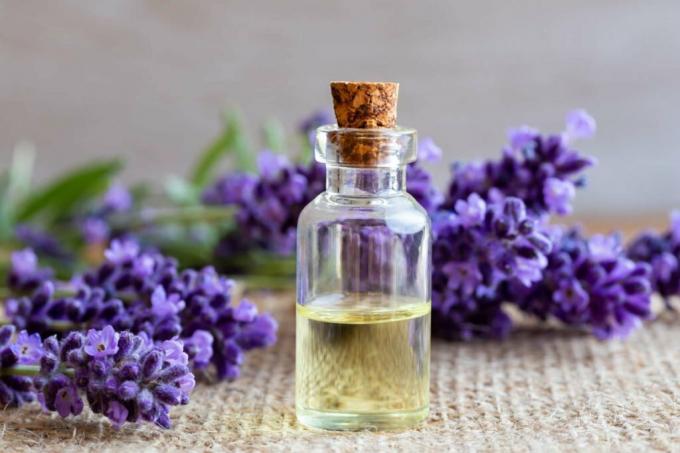
Lavender: Use as a medicinal plant
The essential lavender oil is used both in cosmetics and in natural medicine and is considered effective against fungi and bacteria. Lavender is also used to treat skin impurities, burns and inflammation. A particularly high concentration can be found in the flowers, from which the essential oil is extracted by steam distillation. Although distilling essential oil at home is entirely possible, the fresh or dried lavender flowers can also be preserved in oil. It is important that all parts of the plant are well covered with oil so that no mold forms. After 10 to 14 days, the lavender oil is ready and can be used, for example, as a massage oil to relieve muscle tension or as a relaxing bath additive. Bath salts with lavender flowers are also quick and easy to make.
Lavender: Use in kitchen and household
Incidentally, the production of delicious herbal oil for the kitchen is just as easy. Due to its intense aroma, however, lavender is only used sparingly in the kitchen or in combination with other herbs and spices. However, lavender often gives Mediterranean dishes the final kick and is often included in the "Herbs of Provence" mix, for example. It goes particularly well with lamb, poultry, feta and goat cheese, grilled vegetables or salads. But despite its unlimited uses in the kitchen, the question arises again and again as to whether lavender is not toxic to humans and pets.
In our special article we deal with the myth of poisonous lavender after.
Since lavender is easy to dry and retains its intense violet colour, the dried flower spikes are very suitable for decoration. And of course you can also fill scented cushions with lavender blossoms from your own garden.
Lavender against mosquitoes and moths
While people usually find the scent of lavender pleasant and calming, the smell has a rather repellent effect on many insects. As a mosquito repellent, for example, self-made lavender oil is very useful. Apply the oil to all unclothed parts of the body. Another possibility is, for example, spraying the clothes with lavender hydrolate, a by-product of the production of lavender essential oil.

To ward off clothes moths, you can easily make a delicately scented ironing water with distilled water and a few drops of essential lavender oil. It is best to fill the mixture into an empty spray bottle and moisten the laundry with it before ironing. Another option is to sew a scented sachet for the closet. Filled with dried lavender flowers and placed between the clean laundry, it keeps annoying moths away. However, you should change the contents of the sachet every now and then, as the scent will fade over time.
Lavender: diseases and pests
Real lavender is an undemanding plant and due to its high proportion of essential oils it is avoided by most predators. However, waterlogging, which can lead to root rot, can be really dangerous for lavender. But this can be well prevented by a drainage layer, a permeable soil and only moderate watering. However, too much moisture also makes the plants susceptible to fungal diseases, which usually show up as brown or black spots on the leaves. Infected plant parts should be removed immediately to prevent further spread of the infection.
More hints on how to Grow lavender can be found in our special article.


